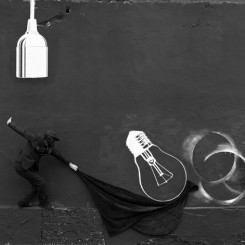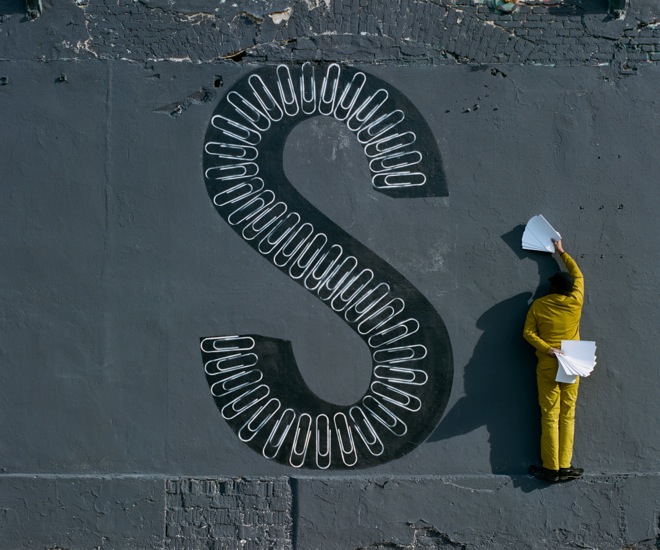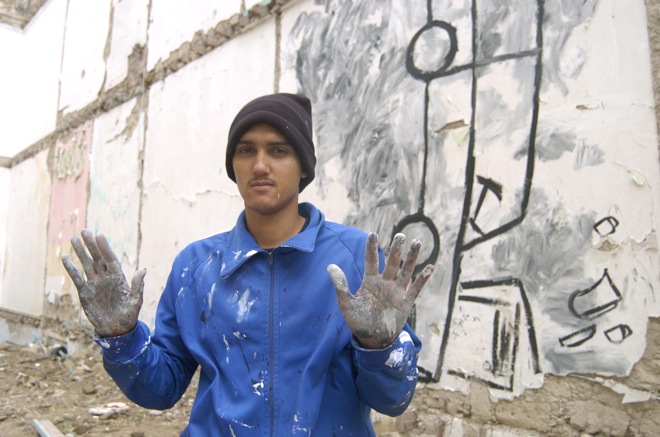本文仅限英文阅读
“having been there”: solo show by Robin Rhode
Lehmann Maupin Hong Kong (407 Pedder Building, 12 Pedder Street, Central, Hong Kong) Sep 17–Nov 1, 2014
Robin Rhode (b. 1976, Cape Town, South Africa) creates wall-based illusions which blur drawing, performance, and photography. With hastily drawn forms serving as props for postures captured stop-motion-style, Rhode has hit upon a narrative technique that is inspired not just by guerilla graffiti performances, but flip-books, magic tricks, and—it turns out—a particular teenage experience. Since his solo show at Haus der Kunst, Munich (2007), Rhode has had a number of shows around the world—most recently at Lehmann Maupin Hong Kong. To rough things up, perhaps, at the opening night in Hong Kong, aside from presenting his works, he rambunctiously attacked the wall with drawings, jostling not a few champagne-sipping ladies along the way.
Daniel Szehin Ho: One thing I really noticed is that you have a signature wall—one wall again and again. Perhaps you could tell me about that wall.
Robin Rhode: One thing that’s really interesting about this particular show is that the works are all produced on one wall. I became so attracted to this particular wall because it had this ledge; I’m drawn to the physical characteristics. I see walls in cities all over the world, but I’m attracted to one wall in a city—it’s this wall, which no longer exists, in fact. It was torn down some months ago.
I love this ledge because it actually allowed me to stay off the ground. If you look at all the photography, I’m never on the surface; I’m always jumping up onto this ledge—this thin ledge. After running, I jump onto that ledge; it always means more physical tension. To run and jump and to be photographed when I’m here, and I’m actually falling, and the photographer catches me at that moment (claps his hands). I think it’s important in the photography to capture the dynamism in the image. Through close inspection you see a certain physicality in that, through gravity.
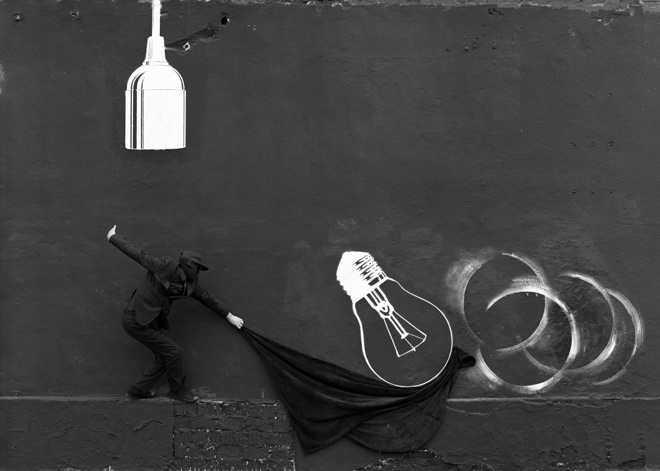
Robin Rhode, “Latimer’s Light” (detail), mounted c-prints, 4 panels, each: 50 x 70 cm, overall: 105 x 145 cm, edition of 5, 2014 (Courtesy the artist and Lehmann Maupin, New York and Hong Kong)
DH: On the other hand, you make it look effortless…
RR: Exactly; you deny that the tension exists, to make it look effortless and light.
DH: Where is this wall?
RR: It’s in Berlin, in an area called Friedrichshain. It’s in East Berlin, close to Warschauerstrasse. It’s photographed in a former train factory, with no roof. It’s got this East German architecture and it’s completely destroyed.
Whenever I photograph walls, I want to make the image completely autonomous. You don’t know where I made that wall—it could be downtown in Mexico City, it could be in Germany, it could be in South Africa, it could be in New York.
DH: I’m almost shocked you say it’s in Berlin, considering how rainy it is there…
RR: You see the rain here….We only have certain periods of the day to photograph because we have shadows coming in from other buildings. This is why I do a lot of my photography in Johannesburg. Germany has its own issues for me working with light, having to access walls, having to work in the summer periods only, or in spring. Even then, there’re all sorts of different cloud conditions.
DH: And they just let you paint over this wall?
RR: No, I rent. So there’s this landlord who actually advertised the wall, because there’s such a huge graffiti culture. But this is how fucked up Berlin is, because it’s also so gentrified at the moment. It appears to be super cool or whatever, but it’s changing all the time. I’ve also worked in places—I worked in a studio a couple of years ago and it no longer exists. It was completely demolished and now there’s a new apartment block there. All these bars, new swimming pools, beaches and sand and all this kind of thing.
I haven’t worked in Berlin for a while…all these works were photographed last year.
There are also a lot of police. There appears to be all this graffiti in Berlin…But I was approached by police even though I was drawing with charcoal and with chalk. There’s a contradiction since people think I work on walls like graffiti artists do—that I do in South Africa. But I rented this wall, and renting this wall allowed me more time to make my work; more time meaning I can be more technical in the realization of the work. I can mess around and experiment. I can take two days to make four photographs. So I can explore the technical aspects of wall drawing a lot more than just adopting the same guerilla graffiti method—which is about speed. My earlier works were about speed, about not getting caught. But now that would be be too obvious and predictable.
There are certain ideas I envisioned for the show in Hong Kong. One that I’m never on the ground, I’m always on the ledge. Two, the idea of using the exact same location, treating the location like a canvas, as in you prime it and you do another piece. The same wall can have so many stories, rather than move from site to site.
DH: This adds to the theatricality of it.
RR: One stage has multiple narratives. I do find other walls. Even in South Africa, I have a wall there. And I’ve produced an enormous amount—it’s a magnificent wall. It’s a big difference. This is controlled; in South Africa, it’s open to the public, so everybody can access it.
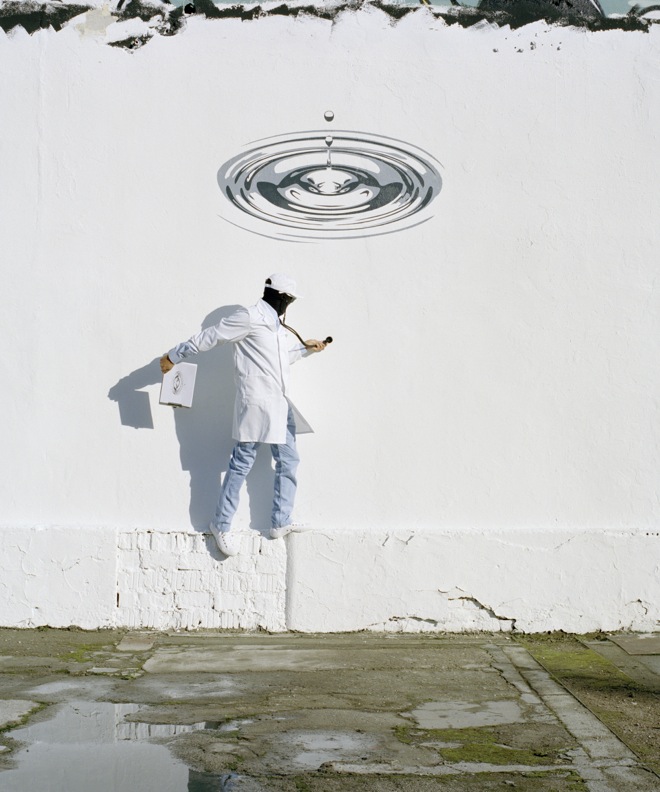
Robin Rhode, “Wall of Water”, mounted c-print, 144 x 120 cm, edition of 5 , 2014 (Courtesy the artist and Lehmann Maupin, New York and Hong Kong)
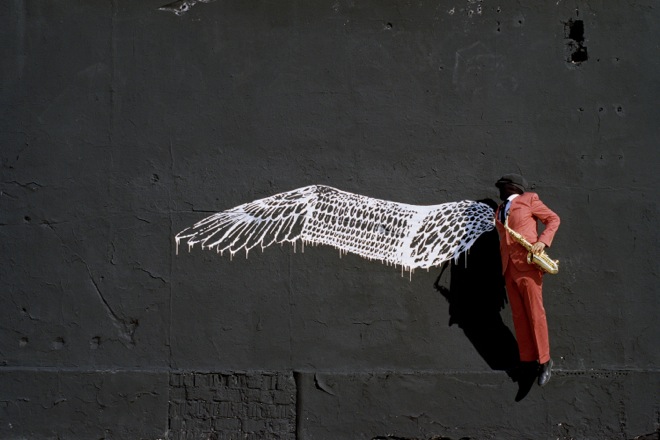
Robin Rhode, “Birdman”, mounted c-print 75 x 115 cm, edition of 5, 2014 (Courtesy the artist and Lehmann Maupin, New York and Hong Kong)
DH: Do they tag it?
RR: They do, and then I bomb them out, and then they start a fight with me, and then it’s a big thing. Once a landlord had this issue with me, and then I exchanged a bottle of whiskey with him. I think it’s healthy to have that difference.
There’s definitely a big street sub-culture in Berlin, but then again, I’m an outsider there. So it’s a bit difficult to engage. I have a lot of insecurities as a foreigner, especially as an African artist with a German visa. I don’t want to fucking go around every German city tagging the walls and getting caught—I’d get fucking deported.
It’s an open wall here—people can look through fences and walls and see the whole situation.
DH: And after each performance, it stays up there for a while?
RR: This last piece I did there was the lightbulbs piece, and we left it there for the landlord to cover over. It’s completely different from the pieces in South Africa where I leave it up for the community, for the public—and everyone loves it. And no one dares tag it now. The community knows. People get out of their cars and watch. Kids from school, they come and watch me, as if it’s theater. They watch the narrative, the process.
The children come one day and see “Today you did that”. And the next day, “Today it’s evolved into this.” They see there’s a camera involved, and they get that it’s being set up for the camera. They watch me paint…erase…paint…erase…they see this character perform—this live theater in front of them on the streets.
I have different characters—homeless people, people coming out from the factories, neighbors, drug addicts, a range of people in the community who have access to my artistic process. It’s one of the most amazing parts about working as an artist there in Johannesburg, having these people coming in. There are even guys now who come and buy beers and chill out and watch me. By the time I’m finished, they’re fucking drunk.
I do enjoy it, but it’s difficult to focus. I’m painting, but they’re passing comments. “Yeah, he’s jumping.” Everybody has a comment. I think it’s great that they see the process—and then it exists in a gallery in another part of the world in a different form.
DH: You always want to show the illusion, too. You want to be the magician but then you constantly expose the process.
RR: The fact that it’s captured in the film—the public sees it on the camera. I’ve been asked so often to show the exterior of the pieces—“Show us who’s around you”. I’m not interested in that—being a voyeur and making the audience the subject.
DH: I read about this bike incident in high school. What was this about?
RR: So what happened was that in high school, we had various kinds of initiation subcultures, so you become part of this kind of group, you know. You have to pass these kinds of tests to become part of our group, part of our sub-culture, part of us. One of the things we did was to draw these objects on the walls and force young kids to interact with it.
DH: It’s remarkably inventive.
RR: It’s remarkably inventive, yes. Why? I ask myself as a student. When I started to study as an art student, and you look at the early performance art, for example, or Duchamp’s pieces, or the basic studies in cave paintings—and in southern Africa are some of the most sophisticated cave paintings in the world from the Bushmen, documenting the hunt, the desire, the dream. We will capture that animal in our hunt, we will succeed, we will disguise ourselves as the animal in order to hunt it.
Through that, I came to decode this experience I had in high school. Why did we do that? There was no art education. Mandela was in 1994; during the 1990s there was zero art education. We stole the chalk—the symbol of the most simple expression. There was this economy of means. There was no canvas or paper—we drew on the gray concrete walls of the toilet. We drew objects from reality that evoked movement, so the performance could deny movement. To play with the sense of the bike moving quickly through space, but denying it. No student was allowed to go to school by bicycle, because going to school by bike evoked fighting and conflict. Guys stealing bikes in the school and fights breaking out over bikes being stolen, wheels being taken off—it was so intense. This was the symbol of our desire—this beautiful golden object.
Only through deciphering this later—I realized I had the language of art in the palm of my hands, I have experienced it. I realized this was my authentic language, not informed by art history. Not looking at that and think it’s cool, and then combining this with that technique and combine this kind of palette—no. This is a hybrid language formed through a subculture of subversion.
DH: So you tried to resist the influence of art history?
RR: No, it’s definitely a massive influence. But I can be influenced by it through my own language, using it to reflect and critique art history. There’s a very emotive power. I feel it’s a truth, you know what I mean. It’s as though I can’t fail—maybe my concepts fail, but I know I’m being truthful to this experience I had in my life, not just something I absorbed.
DH: But you do treat it quite formally?
RR: Sure, but it all goes back to the fundamentals of it.
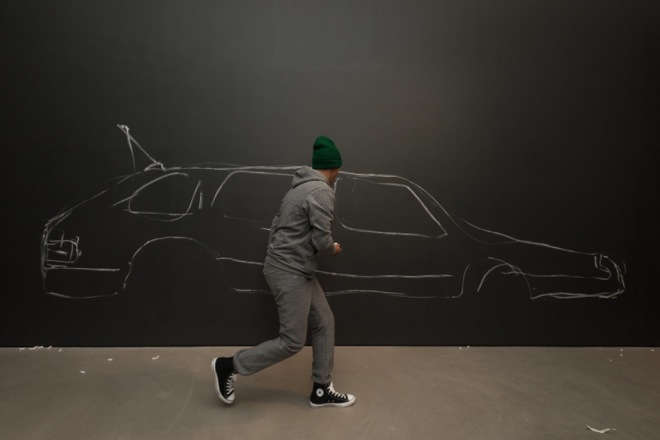
Robin Rhode, “Car Wash”, performance at Lehmann Maupin, Hong Kong, September 17, 2014 (Courtesy the artist and Lehmann Maupin, New York and Hong Kong; photo: Kitmin.com)
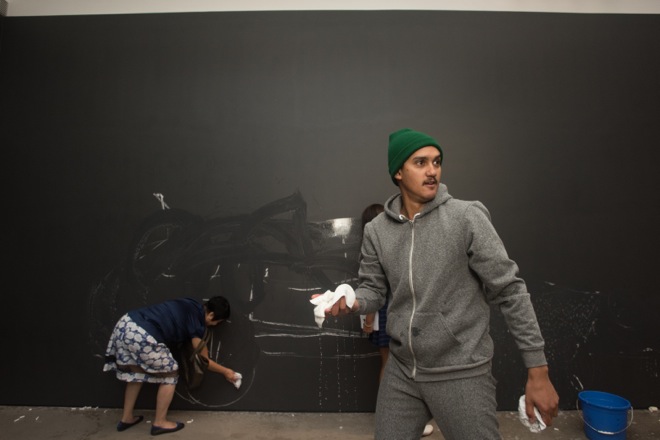
Robin Rhode, “Car Wash”, performance at Lehmann Maupin, Hong Kong, September 17, 2014 (Courtesy the artist and Lehmann Maupin, New York and Hong Kong; photo: Kitmin.com)
DH: You seem not to go for overt political statements. You hint at it, but you don’t try to make a public statement.
RR: I like to be very playful with the ideas, flirt, which then allows you to disguise it as an artist, to add an ambiguity. I can’t say from a personal point of view I’m super political. I’m also very influenced by pop culture, music videos, fashion, design.
DH: The humor brings people—a lot of your pieces have this humor that plays with vision and gesture.
RR: It came very organically. I grew up in this society that was very gestural, very playful—because of the political situation. Past generations grew up under a very different environment, but as a child, this play was very important as a coping mechanism. You develop the language of play and gesture to flip that over, and to go beyond. It took me years to understand why this was important, why it was important to crack jokes in the face of racism, to subvert that with playful things, to laugh in the face of power.
You think of how important it was in the times of kings and queens that you had the joker, who tells the truth in a funny way.
There are incredible stories. My Father used to do sport—cricket, a very formal game where everyone was white. And my Father was playing not too far from my home, on this beautiful cricket field. There was a political rally, and it got violent. The police came—this was in 1991—the riot police comes, and start shooting tear gas in the stadium. And the people start running out across the cricket field where my Father played. As they were running, they start shooting—rubber bullets into the ground. And my Father was with the bat. And he gets hit in the face by a rubber bullet. And he comes home covered in blood over his white clothes, and he’s absolutely calm. It’s the absurdity of him, coping with it just fine. They were having a barbecue….
As a teenager in that situation, seeing them cope with the situation in that way… Maybe it was a way of protecting my brother and I, dealing with it in a very playful manner, with the absurdity. It was just an example of how people dealt with it. He could have taken a case against the police in the Truth and Reconciliations in the late 1990s, but many people suffered worse things than that. My Father was fortunate. Even in the face of danger, we can play. It’s a powerful mechanism, a powerful tool.
•••
When I was first asked to have this show in Hong Kong, it actually opened out a lot of freedom in my work. I didn’t feel bogged down by any political situation. I felt I could explore and be very experimental in my work. Sometimes we get bogged down by the context, which you have to navigate.
I was just going to make a celebratory mood, a mood of freedom. In New York, you always have to make that statement. There’s so much going on, and to get the attention, you have to say something to make your voice heard. Here, I’m not going to stress out. Let me make a jazz piece, with champagne, with the wire. I grew up with a lot of American influence, pop culture. My work had so much influence from there—how would my work reflect and critique that? Whereas in Hong Kong, it’s a clean slate.
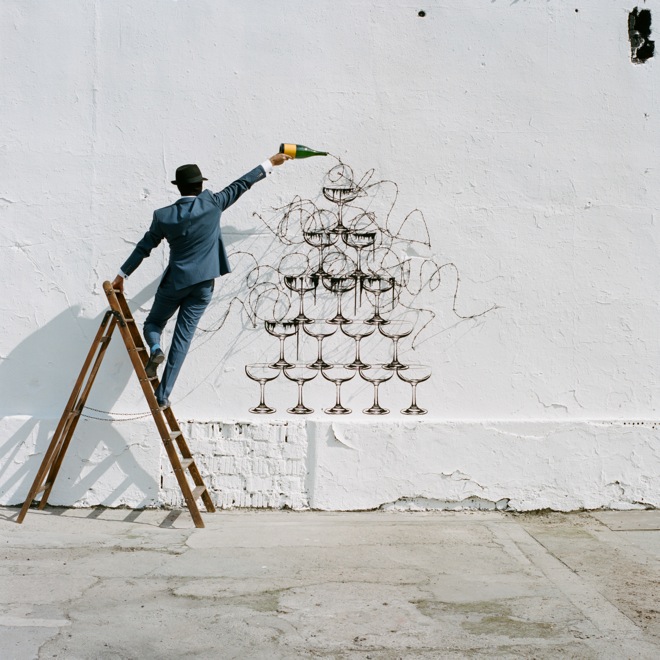
Robin Rhode, “Fountain”, mounted c-print 15 parts, each: 50 x 50 cm; overall dimensions: 276.5 x 276.5 x 3.8 cm, edition of 5, 2014 (Courtesy the artist and Lehmann Maupin, New York and Hong Kong)
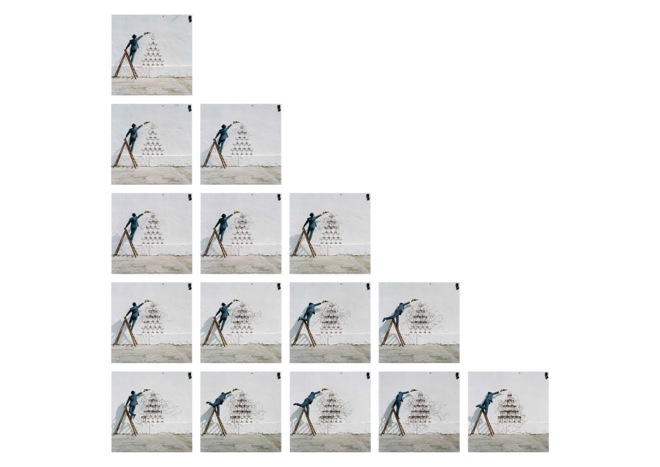
Robin Rhode, “Fountain”, mounted c-print 15 parts, each: 50 x 50 cm; overall dimensions: 276.5 x 276.5 x 3.8 cm, edition of 5, 2014 (Courtesy the artist and Lehmann Maupin, New York and Hong Kong)



